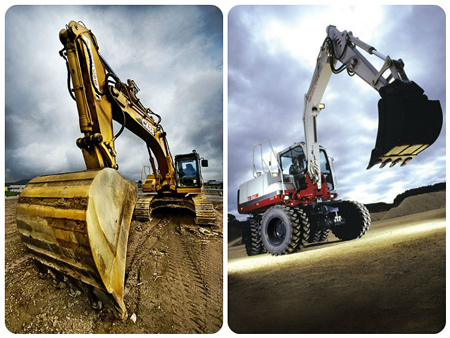Tracked Vs. Wheeled Excavators – How Important Is to Make The Right Choice

The excavator is heavy-duty machine which is used for a variety of tasks in different industry sectors, like construction and mining. It is a powerful machinery which is generally used for excavation jobs and drilling holes into the ground. Many reputable manufacturers design and produce excavators with specific features and specifications. Most of them, design and produce two excavator models: tracked and wheeled excavator. Both models come with similar design and are used for similar applications. However, these machines are different and come with different specifications and configuration. For those who use excavator for the first time, choosing between tracked and wheeled excavator can be a difficult task. The following text will highlight some advantages and disadvantages of both models in order the right excavator to be chosen for a specific application.
Digging Power And Stability. When it comes to the digging performance, the wheeled excavator cannot beat the tracked excavator. Simply said, the wheeled excavators cannot dig aggressively and powerful like the tracked excavators. But when equipped with a quick coupler, the wheeled excavators can use a variety of attachments for performing different jobs in places where other heavy-duty machines cannot work.
When we talk about stability, the tracked excavator has a larger footprint than the contact patch of the wheeled excavator with four tires. Furthermore, the undercarriage of the tracked excavator provides more stability on the ground. The center of gravity is also lower. But the wheeled excavators also stand for stability, because usually they are equipped with outriggers. The outriggers help the machine to stay stable on the ground when preforming the excavation tasks.
Versatility. The tracked excavator is designed to be used for digging applications. It can also use crusher, hammer or shear for performing quarry and demolition works. The wheeled excavator can perform the same jobs, but it can also work on hard surfaces where the tracked excavator cannot move and work. Because of that, the wheeled excavator is ideal machine for works in urban environments, parking lots, paved roadways, building slabs etc. When equipped with different attachments, the wheeled excavator can do a lot more not just digging. It can move concrete barriers, cut asphalt, clean ditches from the surface or grind trees. For small-sized applications in heavy urban environments, most operators choose the wheel excavator.
Mobility And Lifecycle Costs. Most tracked excavators move with speed of around 6-9 km/h. For longer distances, the tracked excavator needs to be placed on a special trailer in order to be transported to the final destination. The wheeled excavators can move with speed of 35 km/h. Mobile and fast, the wheeled excavator improves the productivity on the job site when several tasks need to be completed in one day. When it comes to the cost and price, the tracked excavators are more expensive than the wheeled excavators. The undercarriages of the tracked excavators are quite expensive. Replacing the undercarriages is quite expensive and time consuming task. On the other hand, the wheels of the wheeled excavator are cheap and are easy to replace.



